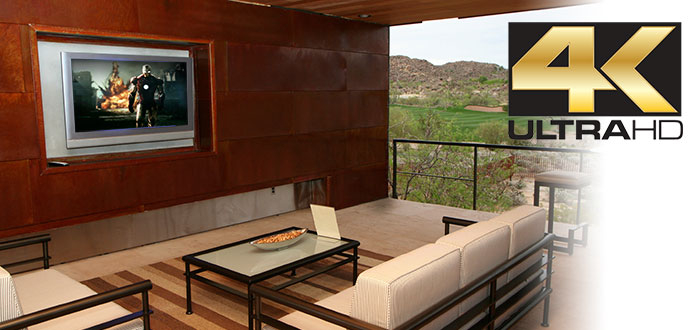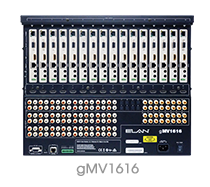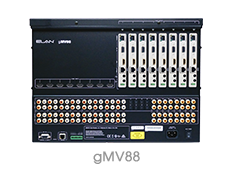UHD 4K video delivers unparalleled clarity and resolution, but like most new AV technologies, UHD 4k comes with certain hurdles. Get past the fear, uncertainty, and doubt and learn Best Practices for UHD 4K in distributed AV systems and learn how the ELAN UltraMatrix is the best solution for UHD 4K as it exists today.
 When
we think of UHD 4K, in many cases we are not just
talking about the resolution of the video, but all
of the signals that accompany that resolution on the
HDMI consumer video format. This includes
multi-channel audio, Display Data Connection (DDC)
content like EDID and HDCP, and 10/100 IP Ethernet.
If we look at the video signal on an even more
granular level, we can separate feature enhancements
beyond the resolution such as High Dynamic Range,
4:4:4 Chroma sub-sampling, Frame Rate, Color Bit
Depth, and Color Gamut; each of which enhance the
clarity of the video signal. But, these feature
enhancements come at a cost.
When
we think of UHD 4K, in many cases we are not just
talking about the resolution of the video, but all
of the signals that accompany that resolution on the
HDMI consumer video format. This includes
multi-channel audio, Display Data Connection (DDC)
content like EDID and HDCP, and 10/100 IP Ethernet.
If we look at the video signal on an even more
granular level, we can separate feature enhancements
beyond the resolution such as High Dynamic Range,
4:4:4 Chroma sub-sampling, Frame Rate, Color Bit
Depth, and Color Gamut; each of which enhance the
clarity of the video signal. But, these feature
enhancements come at a cost.
Distributing UHD 4K requires quite a bit of bandwidth. At its maximum specification (3840×2160 @ 60 FPS (HFR), HDR, 10-bit color, YUV 4:4:4) UHD 4K requires more bandwidth (17.81Gbps) than any current infrastructure cabling or component is capable of, including HDMI. To get all of the data from a source to a display, sacrifices must be made.
Most commonly, manufacturers reduce the Chroma sub-sampling from 4:4:4 to 4:2:0. This reduces the amount of color information each pixel requires by half, which in turn reduces the bandwidth requirements as well (8.91Gbps). The problem with this is that it discards a lot of the data that makes UHD 4K so clear and immersive.
Additionally, some manufacturers are sacrificing frame rate capabilities, opting to support only up to 30 frames per second, rather than 60, which is fine for films and video content that use NTSC standard. For media with computer generated graphics (CGI) like video games, or content shot in high frame rates like sports; a low frame rate can make objects in motion appear blurry with distorted edges.
Furthermore, some manufacturers cut the Bit Depth from 10-bit, as it’s supported on Blu-ray, to 8-Bit, greatly reducing the possible numbers of colors being passed from source to display. The difference is around a billion colors, and can make subtle gradient color transitions appear to have a moire effect.
 Currently,
no manufacturers have created a cross point, capable
of handling higher bandwidth HDMI 2.0 formats such
as UHD 4K 60 4:4:4. Suppliers have not created or
made the chips required to handle this type of
content available at this nascent stage of UHD. Once
the infrastructure technology to support high
bandwidth video switching becomes commercially
available, UHD 4K content will move fluidly in an AV
ecosystem much like 1080P content does now - with
centralized head ends and distributed multi-room
audio/video. Currently ELAN is the only manufacturer
to implement existing technology to get the best UHD
4K experience for their users.
Currently,
no manufacturers have created a cross point, capable
of handling higher bandwidth HDMI 2.0 formats such
as UHD 4K 60 4:4:4. Suppliers have not created or
made the chips required to handle this type of
content available at this nascent stage of UHD. Once
the infrastructure technology to support high
bandwidth video switching becomes commercially
available, UHD 4K content will move fluidly in an AV
ecosystem much like 1080P content does now - with
centralized head ends and distributed multi-room
audio/video. Currently ELAN is the only manufacturer
to implement existing technology to get the best UHD
4K experience for their users.
 In
most cases, UHD 4K content will come from local
streaming sources, like Netflix or M-GO, and service
providers like DirectTV. While UHD Blu-ray content
will be available by the end of 2015; there will
only be a handful of titles, and the first UHD
Blu-ray player (by Samsung) isn’t shipping until
sometime in 2016. In most cases, these sources,
including Blu-ray players will be local to the
display. Without having enough content to demand a
full system upgrade, experts believe consumers will
likely only upgrade a single display in their home.
So far the numbers support this theory, with UHD 4K
TVs having been available in some parts of the world
for nearly 3 years, and sales making up for about 2%
of total HDTV’s sold. With only a single UHD display
in most users' homes, distributing UHD 4K content at
this point does not make sense. There is also a
compatibility issue to take into account.
In
most cases, UHD 4K content will come from local
streaming sources, like Netflix or M-GO, and service
providers like DirectTV. While UHD Blu-ray content
will be available by the end of 2015; there will
only be a handful of titles, and the first UHD
Blu-ray player (by Samsung) isn’t shipping until
sometime in 2016. In most cases, these sources,
including Blu-ray players will be local to the
display. Without having enough content to demand a
full system upgrade, experts believe consumers will
likely only upgrade a single display in their home.
So far the numbers support this theory, with UHD 4K
TVs having been available in some parts of the world
for nearly 3 years, and sales making up for about 2%
of total HDTV’s sold. With only a single UHD display
in most users' homes, distributing UHD 4K content at
this point does not make sense. There is also a
compatibility issue to take into account.
The new HDMI 2.0 spec comes along with a new High-Bandwidth Digital Content Protection (HDCP) standard; HDCP 2.2. This new standard is not compatible with previous versions of HDCP, meaning, new HDMI content and components are not compatible with older HDMI content and components.
Until UHD 4K content becomes ubiquitous enough to drive multiple UHD HDTVs in a home, and the infrastructure technology advances to support UHD distribution, integrators looking to give their customers the best experience should design systems keeping UHD 4K sources local to the display.
 In
situations where an AVR or amplifier is used, audio
signal should be routed back to the head end using
an audio balun, or with UltraMatrix products, using
the Audio Return Path. Using HDMI’s Audio Return
Channel (ARC) requires Consumer Electronics Control
(CEC) to be activated. When CEC is activated,
integrators lose the ability to control a display
via traditional means such as IR, Serial, or IP. The
display is instead linked to the CEC source’s
commands. This can result in a bad user experience;
with a display turning on when someone checks the
disc in a Blu-ray player; or off when the same
player enters standby even if the user is watching
content from another source.
In
situations where an AVR or amplifier is used, audio
signal should be routed back to the head end using
an audio balun, or with UltraMatrix products, using
the Audio Return Path. Using HDMI’s Audio Return
Channel (ARC) requires Consumer Electronics Control
(CEC) to be activated. When CEC is activated,
integrators lose the ability to control a display
via traditional means such as IR, Serial, or IP. The
display is instead linked to the CEC source’s
commands. This can result in a bad user experience;
with a display turning on when someone checks the
disc in a Blu-ray player; or off when the same
player enters standby even if the user is watching
content from another source.
With the ELAN UltraMatrix line of switchers, getting uncompromised UHD 4K and multichannel audio in a distributed AV system is not only possible, it is what the product was designed to do. The UltraMatrix is packed with features; like the Audio Return Path – allowing integrators to return analog or digital multichannel audio from any local source to the system’s head end without engaging CEC, or the ability to deliver 2K resolutions at 60fps and 4:4:4 color sampling. The ELAN UltraMatrix is the only MRAV product on the market today that holistically addresses 4K systems as they are today. For the UHD 4K of tomorrow, ELAN is committed to providing a 4K appointment Program for their customers once the infrastructure technology catches up to the capability of 4K content.
